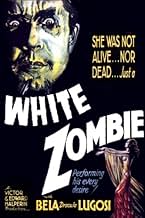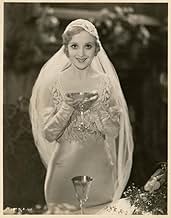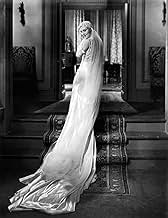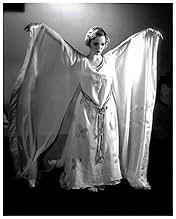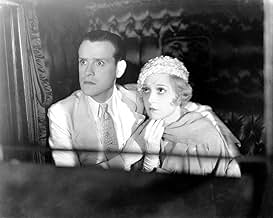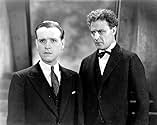AVALIAÇÃO DA IMDb
6,2/10
12 mil
SUA AVALIAÇÃO
Adicionar um enredo no seu idiomaA young man turns to a witch doctor to lure the woman he loves away from her fiancé, but instead turns her into a zombie slave.A young man turns to a witch doctor to lure the woman he loves away from her fiancé, but instead turns her into a zombie slave.A young man turns to a witch doctor to lure the woman he loves away from her fiancé, but instead turns her into a zombie slave.
- Direção
- Roteiristas
- Artistas
John T. Prince
- Ledot - Zombie
- (as John Printz)
Clarence Muse
- Coach Driver
- (não creditado)
Avaliações em destaque
WHITE ZOMBIE is one of those rare early talkies where everything fits just right. Rumours have circulated for years that Bela Lugosi himself actually directed part, if not all, of the movie. Having seen all of the movies made by the Halperin Brothers in the 30's this is deffinitely the best, but DID Bela direct it? There is a quality in this film lacking from all other Halperin films. In many scenes the technique seems to have been borrowed from German silent films and Bela did work with Edgar Ulmer in Germany early in his career. Also notice that WHITE ZOMBIE is essentially a silent film with key scenes performed with a minimum of dialogue . . .or none at all; a standout moment is when Legendre (Bela Lugosi) traps the soul of Madeline (Madge Bellamy) by carving, and then melting, a wax image in her likeness. All without a single word being said. Another key sequence is a montage of scenes set against the haunting spiritual "Listen To The Lambs" performed by an offscreen chorus. Notice also the scene where Neil (John Harron, brother of former silent film star Robert Harron) and Dr. Bruner (Joseph Cawthorn) are talking. The camera starts out behind Harron's back and moves out. It moves in a circle around the room while the men talk and finally goes back behind Harron to end the scene; deffinitely an Expressionist Germanic touch! Granted the film has its flaws, Joseph Cawthorn's character is supposed to be to be a Christian missionary but he has a noticably Yiddish accent. Also for a film that is set in Haiti there is an uncomfortable lack of black characters. Clarence Muse as the coach driver is the only one in the movie! Two other alleged native Haitians are white actors in blackface! Madge Bellamy's bee-stung lips and eye makeup also belong back in a silent film. Weighed against the film as a whole however, these inadequacies are slight. The cast is quite good. Robert Fraser met up with Lionel Atwill in THE VAMPIRE BAT (1934). Clarence Muse met up with Bela again in THE INVISIBLE GHOST (1944). One of the zombies is played by George Burr McAnnan who had played the puritannical leader of the farm community that ostracises unwed mother Lillian Gish in WAY DOWN EAST (1920). Also look for Brandon Hurst as a creepy looking butler. He had played the evil Jehan Frollo opposite Lon Chaney's Quasimodo in THE HUNCHBACK OF NOTRE DAME (1923). By all means see this movie! It is well worth your time. So did Bela direct it? Alas we may never know. Then again, in an interview given in the early 1970's Clarence Muse said he clearly recalled Bela directing a few scenes. So maybe . . .
White zombie is recorded as being the first Zombie movie ever mad. They Zombie actors did an amazing job of it, especially when considering they had no bases to work from. It was all about portraying creepy and terrifying through a stiff body poster and facial features. And they pooled it off. It was the "eyes" of Lugosi, the king of Zombies who put the fear in me. Amazing skills as an actor to convey so much with just the eyes. The movie is at one scary, mysterious, weird, and funny. The key feature of White zombie is that it was made to scar the people of its time, not ours. And this is probably why most people won't give it the time of day. It is an old movie with old style acting and scare tactics. The viewer has to know that be for watching it.
A couple of years ago I saw the 1931 version of Dracula as part of a live performance for the new musical score composed by Philip Glass. Even in this refined setting, the film was met by laughter from the audience during several sections. This seemed rather odd to me, but I suppose older horror films cannot help but lose some of their initial impact over time. The black and white photography and performance techniques became antiquated, hence humorous to some. As time went on, filmmakers begin to spoof the broad overacting and dramatic music of the vintage horror picture. It is impossible today to view a film like WHITE ZOMBIE and fully understand the impact it may have had in 1932. It does, however, escape (for the most part anyway) the mirthful reactions described above.
Director Victor Halprin's telling of this tale is often cited as the genesis of the "zombie picture." There is some debate about this, but WHITE ZOMBIE is certainly one of the early films to deal with the Haitian legend of "the dead that walk." The story revolves around a young couple who have traveled through Haiti to meet with their friend and benefactor Charles Beaumont (Robert Frazer), at whose villa they plan to be married. He has designs on the young bride, Madeleine (Madge Bellamy), and enlists the help of Murder Legendre (the name kind of says it all) played by Bela Lugosi. After the wedding, Legendre performs some "witchcraft" rituals and Madeleine falls into a death-like state. Believing that she has in fact died, the newly minted groom (John Harron) spirals into a drunken maelstrom, eventually seeking out the learned missionary Dr. Bruner (Joseph Cawthorn) to help solve the mystery. All paths seem to lead back to Legendre as the plot thickens and Beaumont's true motives are discovered.
It is fascinating to watch these type of films, some of which, like WHITE ZOMBIE age well with time. This is partly due to the fact that it has been largely forgotten in the wake of the more successful Universal horror flicks. The main drawn here will be the performance by Lugosi. He essentially "vamps" his role in Dracula, but manages to fashion a fairly distinct and unsettling screen presence. It would be roles like this however that would lead to his rigid typecasting; as time went on, he was all but discarded by the film industry (see ED WOOD [1994] for his later years). Halprin's direction focuses on atmosphere and gloom. He is well paired with cinematographer Arthur Martinelli and together they create a suitably shadow-laden backdrop for this macabre story. WHITE ZOMBIE is ambitious in camera angles and editing. At one point there is a diagonal wipe edit, which stops midscreen to reveal the actions of two separate characters. This type of effect is effortless to achieve now, but must have been laborious in 1932. Observe also the unusually large transitional set of the plantation interior, or the framing of Lugosi though the ornate stone work during certain shots. These small details help set WHITE ZOMBIE apart by creating a realistic environment and aid in visually representing the pathology of the characters.
Since the 30's there has been countless movies about killer zombies run amuck. The concept predominantly became fodder for B-grade schlock productions. The genre would experience something of a renaissance in 1968 with George Romero's NIGHT OF THE LIVING DEAD which created quite a stir at the time and resulted in zombies becoming, once again, fashionable. The Haitian setting of WHITE ZOMBIE would also be revisited in THE SERPENT AND THE RAINBOW (1988) and the "undead" as a means of cheap labor subtext would be exploited for darkly comedic effect in the underrated HBO film CAST A DEADLY SPELL (1991). In recent years, there has been such a boom of these "living dead" productions that it is hard to keep track of them all. WHITE ZOMBIE, as an early example of this current trend, but should be seen as more than just a footnote in the ever growing history of film. It is not a great movie, like Dracula, but will prove to be of interest to film buffs at least. It has more to offer, though, and I hope that it will continue to be rediscovered by successive generations. 7/10
Director Victor Halprin's telling of this tale is often cited as the genesis of the "zombie picture." There is some debate about this, but WHITE ZOMBIE is certainly one of the early films to deal with the Haitian legend of "the dead that walk." The story revolves around a young couple who have traveled through Haiti to meet with their friend and benefactor Charles Beaumont (Robert Frazer), at whose villa they plan to be married. He has designs on the young bride, Madeleine (Madge Bellamy), and enlists the help of Murder Legendre (the name kind of says it all) played by Bela Lugosi. After the wedding, Legendre performs some "witchcraft" rituals and Madeleine falls into a death-like state. Believing that she has in fact died, the newly minted groom (John Harron) spirals into a drunken maelstrom, eventually seeking out the learned missionary Dr. Bruner (Joseph Cawthorn) to help solve the mystery. All paths seem to lead back to Legendre as the plot thickens and Beaumont's true motives are discovered.
It is fascinating to watch these type of films, some of which, like WHITE ZOMBIE age well with time. This is partly due to the fact that it has been largely forgotten in the wake of the more successful Universal horror flicks. The main drawn here will be the performance by Lugosi. He essentially "vamps" his role in Dracula, but manages to fashion a fairly distinct and unsettling screen presence. It would be roles like this however that would lead to his rigid typecasting; as time went on, he was all but discarded by the film industry (see ED WOOD [1994] for his later years). Halprin's direction focuses on atmosphere and gloom. He is well paired with cinematographer Arthur Martinelli and together they create a suitably shadow-laden backdrop for this macabre story. WHITE ZOMBIE is ambitious in camera angles and editing. At one point there is a diagonal wipe edit, which stops midscreen to reveal the actions of two separate characters. This type of effect is effortless to achieve now, but must have been laborious in 1932. Observe also the unusually large transitional set of the plantation interior, or the framing of Lugosi though the ornate stone work during certain shots. These small details help set WHITE ZOMBIE apart by creating a realistic environment and aid in visually representing the pathology of the characters.
Since the 30's there has been countless movies about killer zombies run amuck. The concept predominantly became fodder for B-grade schlock productions. The genre would experience something of a renaissance in 1968 with George Romero's NIGHT OF THE LIVING DEAD which created quite a stir at the time and resulted in zombies becoming, once again, fashionable. The Haitian setting of WHITE ZOMBIE would also be revisited in THE SERPENT AND THE RAINBOW (1988) and the "undead" as a means of cheap labor subtext would be exploited for darkly comedic effect in the underrated HBO film CAST A DEADLY SPELL (1991). In recent years, there has been such a boom of these "living dead" productions that it is hard to keep track of them all. WHITE ZOMBIE, as an early example of this current trend, but should be seen as more than just a footnote in the ever growing history of film. It is not a great movie, like Dracula, but will prove to be of interest to film buffs at least. It has more to offer, though, and I hope that it will continue to be rediscovered by successive generations. 7/10
I'm a big Bela Lugosi fan, as well as a sucker for '30s and '40s horror chestnuts in general. But no matter how many times I watch WHITE ZOMBIE, I'm just always a bit short of considering it a "good" movie. Lugosi is delightfully weird and mysterious as Murder Legendre, a sinister zombie master who commands a legion of Walking Dead, and who grants a favor to a jealous man by helping him possess the woman he yearns for -- by turning her into a mindless zombie!
The surroundings are purely macabre and unsettling. But despite these assets, something goes astray in the snail-like pacing. Some of the acting is hopelessly dated and exaggerated, most notably by con man Robert Frazer and, to a lesser extent, hero John Harron. It's interesting that Lugosi - who's often lambasted by critics for overdoing it himself - is perfectly "on," however.
WHITE ZOMBIE is still a "pretty good" horror movie in its own right for such a minor production. But it's not a film I would recommend to those younger viewers who tend to feel bored by older classic films.
The surroundings are purely macabre and unsettling. But despite these assets, something goes astray in the snail-like pacing. Some of the acting is hopelessly dated and exaggerated, most notably by con man Robert Frazer and, to a lesser extent, hero John Harron. It's interesting that Lugosi - who's often lambasted by critics for overdoing it himself - is perfectly "on," however.
WHITE ZOMBIE is still a "pretty good" horror movie in its own right for such a minor production. But it's not a film I would recommend to those younger viewers who tend to feel bored by older classic films.
Zombie movies from the '30's and '40's are quite different from the zombie movies most people know from the '70's till present time. In the '30's and '40's, zombies and voodoo kind of rituals always walked hand in hand. As a result of this zombie movies from the '30's and '40's have a certain creepy atmosphere and scary voodoo sound effects.
"White Zombie" is the very first (still excising) zombie movie ever made. The zombies look extremely good and creepy thanks to the charismatic actors that perform them. Don't underestimate this people, acting with just your body and mostly face is also a form of tough acting. I think that it is thanks to the fine casting of the zombies that most of the scene's with them in it, work really well.
Bela Lugosi is totally fantastic as sort of witch doctor and 'king of the zombies'. He plays one scary monsieur. I even tend to say that this is his best villain role he has ever portrayed, yes even better as Count Dracula. Lugosi was always at his best in roles like these and just like in "Dracula" he is once more acting very well with also both his hands and face, especially his typical horror-like-eyes make him one legendary villain. For the Lugosi fans this is an absolute must see!
The story is very intriguing and sad and its told in a beautiful way. Especially the ending was fantastic and actually also quite tense.
Unfortunately time has not been kind on this movie. The movie had been lost for many years until the '60's after acquiring the rights to distribute the movie, the quality was already beyond restoration, so now days we can never watch this movie in its full glory. The movie has the grainy and visual look of movies from the 1920's and at times small chunks of sound and music are missing.
The cinematography is absolutely fantastic and the experimental editing provides some unique and extremely well looking sequences. It reminded me of some of Brian De Palma's early work. There is one unique and brilliant scene that I can't even describe. It features a split screen but the scene is constructed more complex than I make it sound. Really something you have to see for yourself.
OK maybe the beginning of the movie isn't that good and memorable and quite standard and typical for the horror genre in the '30's but the last half hour or so is really unique, excellent, tense and just a shear delight to watch, mainly thanks to Bela Lugosi's his character 'Murder' Legendre (what a brilliant name by the way) and the story in which once more love conquers all.
By the way this is the movie Ed Wood and Bela Lugosi were watching together in the movie "Ed Wood". Most people think that it was a Dracula movie with Lugosi but it in fact is this movie they're watching.
A really unique little forgotten horror masterpiece, that's worth seeing already alone for its movie historical value and Lugosi's fantastic, passioned villain role.
8/10
http://bobafett1138.blogspot.com/
"White Zombie" is the very first (still excising) zombie movie ever made. The zombies look extremely good and creepy thanks to the charismatic actors that perform them. Don't underestimate this people, acting with just your body and mostly face is also a form of tough acting. I think that it is thanks to the fine casting of the zombies that most of the scene's with them in it, work really well.
Bela Lugosi is totally fantastic as sort of witch doctor and 'king of the zombies'. He plays one scary monsieur. I even tend to say that this is his best villain role he has ever portrayed, yes even better as Count Dracula. Lugosi was always at his best in roles like these and just like in "Dracula" he is once more acting very well with also both his hands and face, especially his typical horror-like-eyes make him one legendary villain. For the Lugosi fans this is an absolute must see!
The story is very intriguing and sad and its told in a beautiful way. Especially the ending was fantastic and actually also quite tense.
Unfortunately time has not been kind on this movie. The movie had been lost for many years until the '60's after acquiring the rights to distribute the movie, the quality was already beyond restoration, so now days we can never watch this movie in its full glory. The movie has the grainy and visual look of movies from the 1920's and at times small chunks of sound and music are missing.
The cinematography is absolutely fantastic and the experimental editing provides some unique and extremely well looking sequences. It reminded me of some of Brian De Palma's early work. There is one unique and brilliant scene that I can't even describe. It features a split screen but the scene is constructed more complex than I make it sound. Really something you have to see for yourself.
OK maybe the beginning of the movie isn't that good and memorable and quite standard and typical for the horror genre in the '30's but the last half hour or so is really unique, excellent, tense and just a shear delight to watch, mainly thanks to Bela Lugosi's his character 'Murder' Legendre (what a brilliant name by the way) and the story in which once more love conquers all.
By the way this is the movie Ed Wood and Bela Lugosi were watching together in the movie "Ed Wood". Most people think that it was a Dracula movie with Lugosi but it in fact is this movie they're watching.
A really unique little forgotten horror masterpiece, that's worth seeing already alone for its movie historical value and Lugosi's fantastic, passioned villain role.
8/10
http://bobafett1138.blogspot.com/
Você sabia?
- CuriosidadesWas a personal favorite of Bela Lugosi, according to his son, Bela Lugosi Jr..
- Erros de gravação(at around 46 mins) The vulture manages to scream, loudly and repeatedly, with its beak shut.
- Citações
Madeline: Driver, who were those men we saw?
Coach Driver: They are not men, madame. They are dead bodies!
- Cenas durante ou pós-créditos"White Zombie starring Bela (Dracula) Lugosi."
- Versões alternativasThe scene is which the zombie is crushed by the grinder, after falling into the chute in the factory, is missing from most available prints.
- ConexõesEdited into Revolta dos Zombies (1936)
- Trilhas sonorasBridal Chorus (Here Comes the Bride)
(uncredited)
from "Lohengrin"
Music by Richard Wagner (1850)
Played on an organ for the wedding
Principais escolhas
Faça login para avaliar e ver a lista de recomendações personalizadas
- How long is White Zombie?Fornecido pela Alexa
Detalhes
- Data de lançamento
- País de origem
- Idioma
- Também conhecido como
- Zumbi Branco
- Locações de filme
- Empresa de produção
- Consulte mais créditos da empresa na IMDbPro
Bilheteria
- Orçamento
- US$ 50.000 (estimativa)
- Tempo de duração1 hora 9 minutos
- Cor
- Proporção
- 1.37 : 1
Contribua para esta página
Sugerir uma alteração ou adicionar conteúdo ausente

Principal brecha
By what name was Zumbi, A Legião dos Mortos (1932) officially released in India in English?
Responda


